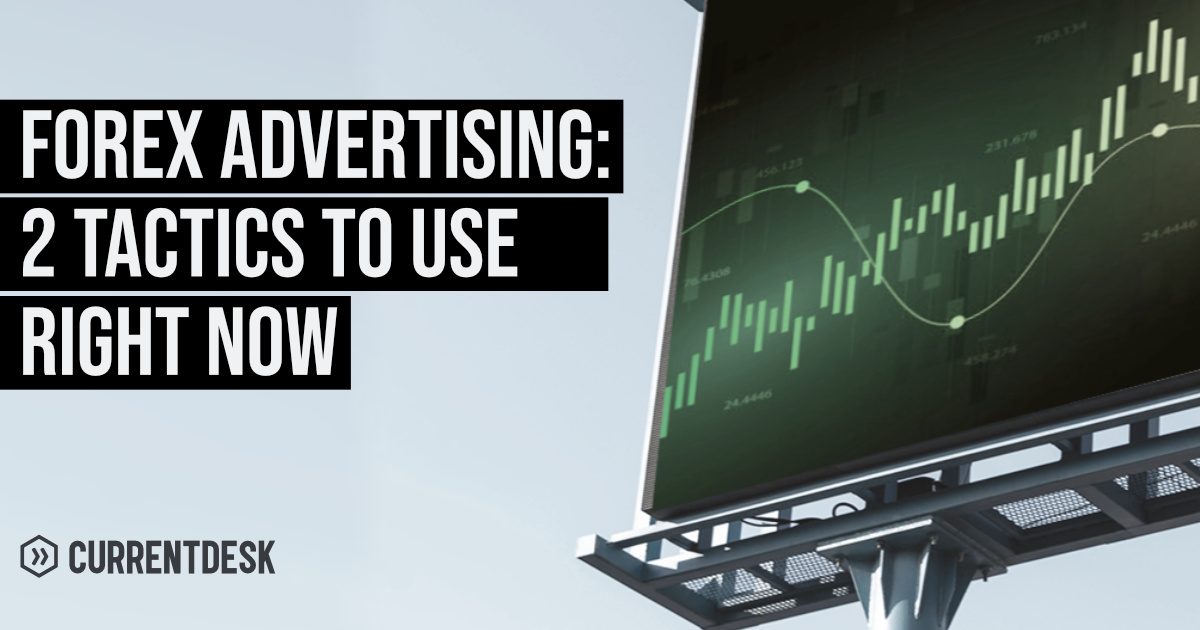Forex Advertising – 2 Tactics to Use Right Now

As a broker, it can be tough to establish your brand across every customer touch point out there; from social media to broker directories, channels and their respective traffic change so frequently. So where can you focus your efforts right now? Where is the most suitable place to advertise Forex for your FX brokerage?
In this post, we’ll explore two top strategies you can use to drive down your cost per acquisition and increase your leads, while also boosting the lifetime value of your clients and improving retention.
What tactics do brokers use to market themselves?
Let’s start off by defining what strategies the industry gravitates towards or consistently favors.
Forex marketers are accustomed to using a varied approach in their FX advertising strategies. It’s common to see a mix of tactics including content production, search engine marketing, social media engagement, direct media buying, broker directory listings, email marketing and community selling.
Since the start of COVID-19 the industry has seen a huge increase in interest and new potential traders joining the marketplace. Activities have shifted to mainly online interactions and it’s clear that having a strong digital presence right now will mean that you can boost your competitive visibility.
Analyzing Forex lead flow
So, what does that mean for Forex marketing and gaining new clients? Why is constant analysis of the channels you elect to use so important?
Unfortunately, traders have experienced a lot of exposure to the dangers of FX trading in the past few years, wherein some unethical brokers gave the market a bad reputation. Hard-sell pressure tactics that some brokers used created an environment that was very unattractive to prospective traders. That’s why building trust and strategically planning a marketing mix and channel choice has become paramount to the success of a modern brokerage.
To find the best ways of attracting new clients, your team will want to be analyzing and identifying your most effective channels on an ongoing basis. Conducting this research will help you find what content on what channels attracts more Forex traders while ensuring you get the most effective cost per acquisition (CPA)for each new trader signup.
However, now more than ever, brokers should be building a more customer-centric strategy and message. Teams should avoid over-prioritizing cost per lead (CPL), CPA,or highest first-time deposit (FTD) channels, but also consider the importance of the LTV (Lifetime Value) of a potential trader, building long term trust and ways to increase retention.
So what are some useful Forex marketing strategies to use right now?

To help promote trust and engagement, we see these two strategies as a key part of a modern broker’s strategy:
-
Social Media Marketing
-
Content marketing
Let’s dig in a bit more to explain why.
1. Social Media marketing for Forex brokers
Social media channels have been taking over our lives for some time now. They are integral parts of our day to day routines, whether that’s Facebook, Twitter, YouTube or messaging apps like Telegram and WhatsApp.
With 3,2 billion people using social media (which accounts for 42% of the population globally), the importance of an FX broker’s presence on social media channels is undeniable.
Furthermore, Forbes, emphasizes the importance of a positive experience and interaction with a brand on social media, stating that 49% of questionnaire respondents say that they are likely to share a brand or recommend it to their family and friends simply because of positive interactions on social media channels.
Access to worldwide exposure

In a highly competitive environment such as the FX industry, if you are not on social media, it can feel like your business doesn’t exist. To stay relevant on traders’ social media feeds, FX Brokers should establish a brand presence on multiple platforms. The value behind creating such a vast network of touchpoints is that when potential clients are presented with a new brokerage, the first thing they will do is evaluate their Facebook or LinkedIn pages, Twitter activity, or Youtube channel to gauge its credibility and form a deeper impression. No presence, or a weak presence, can translate into distrust.
Without trust, the trader will stop their engagement before you get a chance to draw them in as a client.
Personalized communications and community building
Social media platforms allow for interactions to take place between the broker and the trader directly. It’s easy to build experiences that are genuine and personal, and gain a trader’s trust. Assigning a “human face” or “voice” to the brand via direct messages, comment threads and a well-curated series of posts creates a relationship that is great for long term retention.
Customer experience can also be significantly enhanced by using social media. Support interactions with the brand on social media channels enable quick responses to client questions and lead to higher trader conversions and retention.
Also, by using these digital conversations to build a community within niche industries like FX, traders can be brought together, creating a sense of community and camaraderie. Your online groups can be a place where they can interact and share experiences, answer questions and start discussions with themselves or guided by your community managers.
How do brokers market themselves on social media channels?
Generally, brokers publish template-based images, captions, graphics or tables and strategic redirect links to their social media channels to promote their services, stay “present” on their followers’ feeds and demonstrate brand identity. Some of the most common types of posts include:
- Market updates
- Blogs and tips
- Motivational pictures and success metrics posts
- Technical Analysis
Just remember that differentiating yourself with an interesting or likeable brand presence will boost visibility and credibility at the same time.
With modern social media tools and a digital new marketing mindset, brokers are reapproaching financial marketing from a different angle. They are producing content that is unique and real life. Some examples include:
- Live Q&A Sessions
- Live Videos
- Unique content that is exclusive to your social media channels and can’t elsewhere
- Unique promotions that can only be claimed through social media channels
- Online group discussions and shared experiences
2. Content Marketing
Now let’s move on to the second engagement channel that we see gaining ground in Forex marketing right now.
When we hear the phrase “Forex content marketing,” it’s not new. What usually comes to mind when brokers create “marketing content” is blog posts and articles.
But “content” is so much more than that; it can include videos, interviews, essays, surveys, whitepapers, illustrations, graphics or charts, emails, case studies, photo albums and essentially anything people spend time viewing/consuming online.
Content marketing also means optimizing content around improving your website’s search engine rankings, optimizing sales processes with collateral and messaging that supports a strong and consistent brand identity, and creating, maintaining and tailoring content to email marketing funnels.
Then there’s also creating scripts for videos that can be posted on YouTube, building testimonial campaigns, infographics, content for educational material and a lot more.
One thing we see as a central pillar for content marketing is that it aims to build trust and engage audiences in a low-pressure environment. They can consume as much as they want, when they want, without being aggressively pushed to buy anything.
One advantage of content marketing is that it can rely on owned media, such as your own websites, email lists or client portal. By approaching clients on your platforms, you won’t need to pay for distribution. This helps reduce your CPA since you are not paying advertisers a fee to promote your message to their audiences.
The case for building brand equity with content
In an online era, traders are working in an environment full of ads, such that every piece of content you serve could be considered a relationship deposit and thus, brand equity.
Brand equity refers to building your relationship with a client. In terms of content, this means you are building content pieces that pass your message to the audience and promote positive associations of value in the consumer’s mind. Rather than bombarding the audience with direct ads, you work on building long term relationships.
When they are ready to take action, they’ll recall who has been supporting or entertaining them all this time and will see your request (Sign Up for Live account/ Demo) as a natural next step in your relationship.
As time passes, and leads turn into clients and clients into traders, you will develop a much deeper relationship with your book contacts. Your content will have seeded them with all the information they need to succeed. Treat these relationships well, and they will likely be strong brand advocates in the future that you can use in your marketing campaigns as testimonials or referral partners.
Final thoughts
When using both social and content channels to promote your brand, consider using elements of personalization. Studies suggest that using personalization can increase revenue from 6-10%
Quite often companies focus on generating leads in the short term and forget about their long term goals and prospects. Effective marketing aims at establishing brand credibility early on and building long term relationships with prospects to turn them into customers when they are ready.
Try using your CRM to segment and profile your client base to build content and social campaigns that match the needs of small niche groups of prospects and traders. You’ll see better engagement rates.
See what you can achieve with CurrentDesk
Schedule a demo with one of our experts
References
- https://emarsys.com/learn/blog/top-5-social-media-predictions-2019/
- https://www.forbes.com/sites/dangingiss/2019/04/10/consumers-are-more-willing-to-share-positive-experiences-than-negative-ones/
- https://currentdesk.com/brokerage-growth/9-forex-social-networks-you-should-use/
- https://www.bcg.com/en-us/publications/2017/retail-marketing-sales-profiting-personalization


Comments are closed.